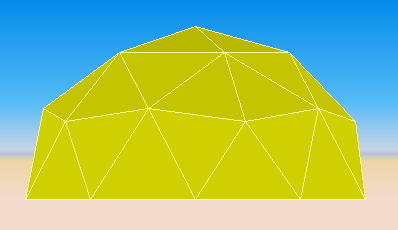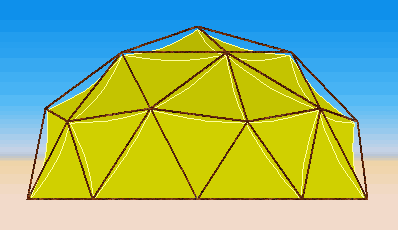Aluminized Mylar, gold lamé, and greenhouse shade cloth all have good attributes as cover materials. And they all have their drawbacks.
| Mylar | Gold Lamé | Shade Cloth |
|---|---|---|
| 😀 Shades 100% | 😀 Shades ??% | 😀 Shades 30%–90% |
| Weak | 😀 Strong? | 😀 Strong |
| Wind Noise | 😀 Quiet | 😀 Quiet |
| 😀 Insulates | Air Flow | Air Flow |
| 😀 Waterproof | Water Resistant? | Water Resistant? |
The question marks show where suspicions need to be confirmed by experimentation.

Shade cloth is the most practical cover solution. 90% black shade cloth would cost a little over $200. It is strong, and it will withstand high winds. It controls the amount of dust that enters the dome, but it is not airtight, and so the air temperature inside will match that outside, unless a water mister is installed.
Anecdotal evidence states paradoxically that black shade cloth will not get hot, possibly due to rising air flow.
Shade cloth is not watertight, but if it is stretched tight, it may be water resistant. (An experiment is necessary to prove that.) Also, shade cloth that is stretched tight will be quiet in the wind.
One disadvantage of black shade cloth is its appearance. As I said, it is a practical solution, providing shelter from the sun and the wind.

Mylar provides 100% shade, and it is 100% airtight. It is possible for a Mylar-covered structure to have a lower temperature inside than outside without a mister, as long as airflow is restricted.
While evidence suggests that Mylar works on small domes, it has been reported to fail on large domes. Success may be related to ease of attachment rather than simple scale. It is known that once Mylar is damaged, it loses all of its strength. The word “ripstop” does not describe Mylar!
One disadvantage of Mylar is that it is noisy in the wind, acting like a drumhead. Mylar may be great for space blankets, but it isn’t the best solution for a dome cover. It does, however, look sharp!

Gold lamé is a tempting material. Although experiments are needed to confirm its performance outdoors, it seems to share all of the characteristics of medium-density shade cloth except strength. Experiments may confirm that it is well suited as tent fabric, being suspended below the dome frame, using tape-reinforced seams.
Gold lamé may fade from exposure to UV light. (Another experiment to do.)
Conclusion
So which is best? Without further information on gold lamé, black shade cloth is best. 2nd place goes to colored shade cloth on the outside with a suspended ceiling inside made of Mylar or a tarp. But if I had the results of test trials, the ranking might change.
It’s time to conduct experiments.
Update: January 3, 2005
I ordered several 2×7 ft samples of shade cloth for the experiments. They should arrive in a few weeks.


